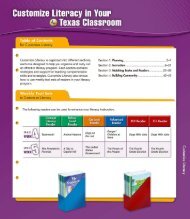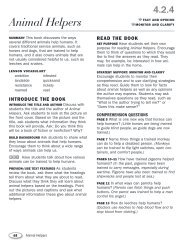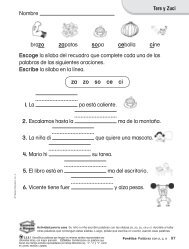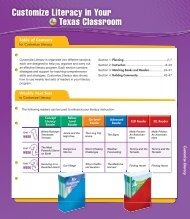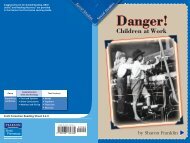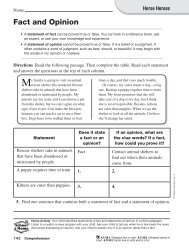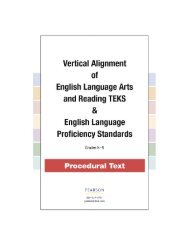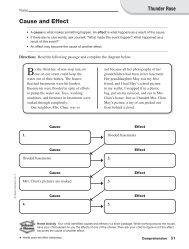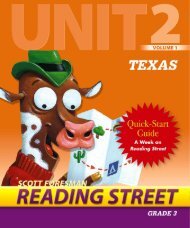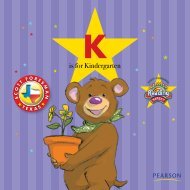“ Abandon<strong>in</strong>g traditionalstatic, ability-group<strong>in</strong>gframeworks allowsstudents of all abilities toachieve higher vocabulary,comprehension, andfluency scores.”Achievement (CIERA), Duke and her colleagues explored this effect directly byexam<strong>in</strong><strong>in</strong>g thirty first-grade classes from thirty elementary schools <strong>in</strong> six low<strong>in</strong>comedistricts randomly assigned to one of three groups (Pal<strong>in</strong>csar and Duke,2004). In <strong>the</strong> experimental group, teachers were asked to <strong>in</strong>clude approximatelyone-third each of <strong>in</strong>formational, narrative, and o<strong>the</strong>r types of texts, such aspoetry or procedural text, <strong>in</strong> classroom activities, <strong>in</strong> <strong>the</strong> classroom library, andon classroom walls and o<strong>the</strong>r surfaces. Teachers <strong>in</strong> <strong>the</strong> exposure control groupwere provided with <strong>the</strong> same amount of money and support to supplementread<strong>in</strong>g materials <strong>in</strong> <strong>the</strong> classroom, but <strong>the</strong>re was no emphasis on diversify<strong>in</strong>g<strong>the</strong> types of texts available <strong>in</strong> <strong>the</strong> classroom. In <strong>the</strong> third, no-treatment controlgroup, teachers were not asked to alter <strong>the</strong> materials used <strong>in</strong> <strong>the</strong>ir classrooms <strong>in</strong>any way.The results of Duke’s study <strong>in</strong>dicated that by <strong>the</strong> end of grade 1, experimentalgroupchildren were better writers of <strong>in</strong>formational text than children <strong>in</strong> <strong>the</strong>control groups, that <strong>the</strong>y had progressed more quickly <strong>in</strong> read<strong>in</strong>g level, andthat <strong>the</strong>y had shown less decl<strong>in</strong>e <strong>in</strong> attitudes toward recreational read<strong>in</strong>g.Experimental classes that entered school with relatively low literacy knowledgeshowed higher overall read<strong>in</strong>g and writ<strong>in</strong>g ability by <strong>the</strong> end of grade 1 thancomparable control classes. This study provides compell<strong>in</strong>g evidence of <strong>the</strong>benefits of <strong>in</strong>creased exposure to <strong>in</strong>formational text <strong>in</strong> <strong>the</strong> early grades.The Benefits of <strong>Read<strong>in</strong>g</strong> <strong>Informational</strong> Text <strong>in</strong> <strong>the</strong> <strong>Early</strong> <strong>Grades</strong>Collectively, <strong>the</strong> research on expos<strong>in</strong>g young children tomore <strong>in</strong>formational texts suggests that <strong>the</strong>re are a numberof benefits to be ga<strong>in</strong>ed from this practice. These <strong>in</strong>cludeevidence that <strong>in</strong>creased exposure is likely to:• make young children better readers and writers of<strong>in</strong>formational text• improve <strong>the</strong>ir vocabulary and comprehension skills• build <strong>the</strong>ir background knowledge• <strong>in</strong>crease motivation for read<strong>in</strong>g• improve home-school literacy connectionsAs Duke and her colleagues argue, <strong>the</strong> most obvious benefitof <strong>in</strong>creased exposure to <strong>in</strong>formational text <strong>in</strong> <strong>the</strong> earlygrades is that it makes children better readers and writers of<strong>in</strong>formational text. However, <strong>the</strong>re is also evidence that read<strong>in</strong>g <strong>in</strong>formationaltexts enhances vocabulary and comprehension skills. Specialized vocabulary is akey feature of <strong>in</strong>formational text (Duke and Kays, 1998), and <strong>the</strong>re is evidencethat even young children learn vocabulary from texts, <strong>in</strong>clud<strong>in</strong>g those that areread aloud (e.g., Elley, 1989). In addition, research <strong>in</strong>dicat<strong>in</strong>g that teachersand/or parents attend more to vocabulary and comprehension when <strong>in</strong>teract<strong>in</strong>gwith children through <strong>in</strong>formational texts supports <strong>the</strong> likelihood that exposureto <strong>in</strong>formational text builds vocabulary, and that general comprehension skillsmay be fur<strong>the</strong>r enhanced through <strong>the</strong>se texts (Pellegr<strong>in</strong>i, Perlmutter, Galda, andBrody, 1990; Smolk<strong>in</strong> and Donovan, 2001).4Research Into Practice • <strong>Pearson</strong> Scott Foresman
To <strong>the</strong> extent that young children’s exposure to <strong>in</strong>formational texts improves<strong>the</strong>ir ability to read and write <strong>the</strong>se types of texts as well as <strong>the</strong>ir vocabularyand comprehension skills, it is also likely to build background knowledge andpromote overall literacy development (see Dreher, 2000). Given <strong>the</strong> importanceof <strong>in</strong>formational texts <strong>in</strong> convey<strong>in</strong>g knowledge about <strong>the</strong> natural and socialworlds, this is a significant factor <strong>in</strong> prepar<strong>in</strong>g young children to read andcomprehend more advanced content-area texts.A f<strong>in</strong>al area of benefit is <strong>the</strong> potential that <strong>in</strong>creased exposure to <strong>in</strong>formationaltexts has for improv<strong>in</strong>g young children’s <strong>in</strong>terest <strong>in</strong> and motivation for read<strong>in</strong>g.At least some children have high levels of <strong>in</strong>terest <strong>in</strong> <strong>in</strong>formational texts ortopics addressed by <strong>the</strong>m, and for those children <strong>the</strong> presence of <strong>in</strong>formationaltexts <strong>in</strong> <strong>the</strong> classroom is likely to be motivat<strong>in</strong>g. Such motivation, <strong>the</strong>n, is likelyto encourage <strong>the</strong>m to read more or to read more productively (e.g., Caswelland Duke, 1998). In addition, evidence that <strong>in</strong>formational texts are read widelyoutside of schools (Venezky, 1982) suggests that exposure to <strong>in</strong>formationaltexts <strong>in</strong> <strong>the</strong> early grades may help children make l<strong>in</strong>ks between home and schoolliteracies. This may be particularly important for children from homes <strong>in</strong> whichstory read<strong>in</strong>g is uncommon (Caswell and Duke, 1998).Although research <strong>in</strong> this area is still <strong>in</strong> its <strong>in</strong>fancy, <strong>the</strong>re is already sufficientevidence to warrant <strong>in</strong>creas<strong>in</strong>g young children’s exposure to <strong>in</strong>formationaltexts as a means of enhanc<strong>in</strong>g a range of literacy skills. As research <strong>in</strong> this areaexpands, we are likely to learn more about which types of <strong>in</strong>formational textscan and should be <strong>in</strong>troduced at different levels of school<strong>in</strong>g, and <strong>the</strong> bestways of teach<strong>in</strong>g young children how to read <strong>the</strong>se texts. Meanwhile, let’s startread<strong>in</strong>g more nonfiction <strong>in</strong> <strong>the</strong> early grades.Research Into Practice • <strong>Pearson</strong> Scott Foresman 5




